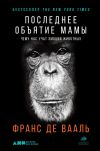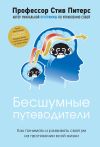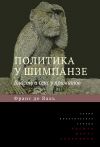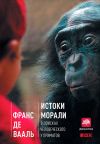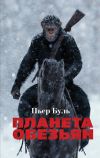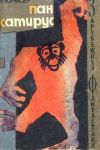Текст книги "О чем рассказали «говорящие» обезьяны: Способны ли высшие животные оперировать символами?"

Автор книги: Анна Смирнова
Жанр: Биология, Наука и Образование
сообщить о неприемлемом содержимом
Текущая страница: 26 (всего у книги 33 страниц)
GALLISTEL 1990 – C. R. Gallistel. The Organization of Learning. Cambridge, MA: MIT Press, 1990.
GALLUP 1970 – G. G. Jr. Gallup. Chimpanzees: Self-recognition // Science. 1970. Vol. 167. P. 86–87.
GALLUP 1982 – G. G. Jr. Gallup. Self-Awareness and the emergence of mind in primates // American Journal of Primatology. 1982. Vol. 2. № 2. P. 237–248.
GALLUP 1994 – G. G. Jr. Gallup. Self-recognition: research strategies and experimental design // S. T. Perker, R. Wb. Mitchell, M. L. Boccia (eds). Self-Awareness in Animals and Humans: Developmental Perspectives. Cambridge Univ. Press, 1994. P. 35–50.
GARDNER ET AL. 1989 – R. A. Gardner, B. T. Gardner, T. E. Van Cantfort. Teaching Sign Language to Chimpanzees. Albany, NY: SUNY Press, 1989.
GARDNER ET AL. 1992 – R. A. Gardner, T. E. Van Cantfort, B. T. Gardner. Categorical replies to categorical questions by cross-fostered chimpanzees // American Journal of Psychology. 1992. Vol. 105. P. 25–57.
GARDNER & GARDNER 1969 – R. A. Gardner, B. T. Gardner. Teaching sign language to a chimpanzee // Science. 1969. Vol. 165. P. 664–672.
GARDNER & GARDNER 1984 – R. A. Gardner, B. T. Gardner. A vocabulary test for chimpanzees // Journal of Comparative Psychology. 1984. Vol. 98. P. 381–404.
GARDNER & GARDNER 1985 – B. T. Gardner, R. A. Gardner. Signs of intelligence in cross-fostered chimpanzees // Philosophical Transactions of the Royal Society of London. Series B, Biological Sciences. 1985. Vol. 308. № 1135. P. 159–176.
GARDNER & GARDNER 1989 – R. A. Gardner, B. T. Gardner. A cross-fostering laboratory // R. A. Gardner, B. T. Gardner, and T. E. Van Cant-fort (eds). Teaching Sign Language to Chimpanzees. Albany, NY: SUNY Press, 1989. P. 1—28.
GARDNER & GARDNER 1998 – R. A. Gardner, B. T. Gardner. Development of phrases in the early utterances of children and cross-fostered chimpanzees // Human Evolution. 1998. Vol. 13. P. 161–188.
GELMAN, GALLISTEL 1978 – R. Gelman, C. R. Gallistel. The Child» s Understanding of Number. Cambridge, MA: Harvard Univ. Press, 1978.
GILLAN 1981 – D. J. Gillan. Reasoning in the chimpanzee: II Transitive inference // Journal of Experimental Psychology: Animal Behavior Processes. 1981. Vol. 7. № 2. P. 150–164.
GILLAN ET AL. 1981 – D. J. Gillan, D. Premack, G. Woodruff. Reasoning in the chimpanzee: I. Analogical reasoning // Journal of Experimental Psychology: Animal Behavior Processes. 1981. Vol. 7. № 2. P. 150–164.
GINSBURG 1963 – N. Ginsburg. Conditioned talking in the mynah bird // Journal of Comparative and Physiological Psychology. 1963. Vol. 56. P. 1061–1063.
GISINER, SCHUSTERMAN 1992 – R. C. Gisiner, R. J. Schusterman. Sequence, syntax and semantics: Responses of a language trained sea lion (Zalophus californianus) to novel sign combinations // Journal of Comparative Psychology. 1992. Vol. 104. P. 368–372.
GOODALL 1965 – J. Goodall. Chimpanzees of the Gombe Stream Reserve // De Vore (ed.). Primate Behavior. N. Y.: Holt, Rinehart and Winston, 1965. P. 287–346.
GOSSETTE ET AL. 1966 – R. L. Gossette, M. F. Gossette, W. Riddell. Comparisons of successive discrimination reversal performances among closely and remotely related avian species // Animal Behavior. 1966. Vol. 14. P. 560–564.
GOSSETTE & GOSSETTE 1967 – R. L. Gossette, M. F. Gossette. Examination of the reversal index (RI) across fifteen different mammalian and avian species // Perceptual and Motor Skills. 1967. Vol. 24. P. 987–990.
GRAMZA 1970 – A. F. Gramza. Vocal mimicry in captive budgerigars (Melopsittacus undulatus) // Zeitschrift für Tierpsychologie. 1970. Bd 27. S. 971–983.
GREENFIELD, SAVAGE-RUMBAUGH 1984 – P. M. Greenfield, E. S. Savage-Rumbaugh. Perceived variability and symbol use: A common language-cognition interface in children and chimpanzees (Pan troglodytes) // Journal of Comparative Psychology. 1984. Vol. 98. № 2. P. 201–218.
GREENFIELD, SAVAGE-RUMBAUGH 1993 – P. M. Greenfield, E. S. Savage-Rumbaugh. Comparing communicative competence in child and chimp: The pragmatics of repetition // Journal of Child Psychology. 1993. Vol. 20. № 1. P. 1—26.
GRIFFIN 1984 – D. R. Griffin. Animal Thinking. Cambridge: Harvard Univ. Press, 1984. 237 p.
GROSSLIGHT, ZAYNOR 1967 – J. H. Grosslight, W. C. Zaynor. Verbal behavior and the mynah bird // K. Salzinger (ed.). Research in Verbal Behavior and Some Neurophysiological Implications. N. Y.: Academic Press, 1967. P. 5–9.
GWINNER 1964 – E. Gwinner. Untersuchungen uber das Auedrucks und Sozialverfahren des Kolkraben (Corvus corax L.) // Zeitschrift für Tierpsychologie. 1964. Bd 21. Hft 6. S. 657–748.
HARLOW 1958 – H. F. Harlow. The evolution of learning // A. Roe, G. G. Simpson (eds). Behavior and Evolution. New Haven: Yale Univ. Press, 1958. P. 269–290.
HARRIS ET AL. 1986 – M. Harris et al. Relations between non-verbal context of maternal speech and rate of language development // British Journal of Developmental Psychology. 1986. Vol. 4. P. 261–268.
HAUSER 1996 – M. C. Hauser. The evolution of communication. Cambridge, MA: MIT Press, 1996.
HAYES & HAYES 1951 – K. Hayes, C. Hayes. The intellectual development of a home-raised chimpanzee // Proceedings of American Philosophical Society. 1951. Vol. 95. P. 105–109.
HERMAN 1986 – L. M. Herman. Cognition and language competencies of bottlenosed dolphins // Dolphin Cognition and Behavior: A Comparative Approach. Hillsdale, NY, 1986.
HERMAN ET. AL. 2001 – L. M. Herman, D. S. Matus, E. Y. K. Herman, M. Ivancic, A. A. Pack The bottlenosed dolphin» s (Tursiops truncatus) understanding of gestures as symbolic representations of its body parts // Animal Learning and Behavior. 2001. Vol. 29. № 3. P. 250–264.
HOCKETT 1960 – С. W. Hockett. Origine of speech // Scientific American. 1960. Vol. 203. P. 88–96.
VAN HOOFF 1967 – J. A. R. A. M. van Hooff. The facial displays of the catarrhine monkeys and apes // D. Morris (ed.). Primate Ethology. London: Weidenfeld and Nicolson, 1967. P. 7—68.
HOFMANN, FRUTH 1994 – G. Hofmann, B. Fruth. Structure and use of distance calls in wild bonobos (Pan paniscus) // International Journal of Primatology. 1994. Vol. 15. P. 767–782.
HOPKINS ET. AL. 1992 – W. D. Hopkins, R. D. Morris, E. S. Savage-Rumbaugh et al. Hemispheric priming by meaningful and nonmeaningful symbols in language-trained chimpanzees (Pan troglodytes): further evidence of a left hemisphere advantage // Behavioral Neurosciences. 1992. Vol. 106. № 3. P. 575–582.
KAKO 1998 – E. Kako. On the proper definition of cognitive ethology // R. P. Balda, I. M. Pepperberg, A. C. Kamil (eds). Animal Cognition in Nature. London: Academic Press, 1998. P. 1—28.
KAMIL 1988 – A. C. Kamil. A synthetic approach to the study of animal intelligence // Comparative Perspectives in Modern Psychology. Lincoln, Nebraska: Univ. of Nebraska Press, 1988. P. 230–257. (Nebraska Symposium on Motivation. Vol. 35).
KARTEN 1991 – H. J. Karten. Homology and evolutionary origins of the neocortex // Brain Behavior and Evolution. 1991. Vol. 38. P. 264–272.
KELLOG & KELLOG 1933 – W. N. Kellog, L. A. Kellog. The Ape and the Child. N. Y.: McGraw-Hill, 1933.
KOEHLER 1956 – O. Koehler. Thinking without words // Proceedings of the 14th International Congress of Zoology, 1953. Copenhagen, 1956. P. 75–88.
KUMMER 1982 – H. Kummer. Social knowledge in free-ranging primates // D. R. Griffin (ed.). Animal Mind – Human Mind: Report of the Dahlem Workshop on Animal Mind – Human Mind, Berlin 1981. Berlin: Springer-Verlag, 1982. P. 113–130.
VAN LAVICK-GOODALL 1968 – J. van Lavick-Goodall. A preliminary report on expressive movements and communication in the Gombe Stream chimpanzees // Primates: Studies in Adaptation and Variability / Ed. P. C. Jay. N. Y.: Holt, Rinchart and Winston, 1968. P. 313–374.
LAWSON, LANNING 1980 – R. W. Lawson, D. V. Lanning. Nesting and status of the Maroonfronted parrot (Rhynchopsitta terrisi) // R. F. Pasquier (ed.). Conservation of New World Parrots. Washington, D.C.: Smithsonian Institution Press, 1980. P. 385–392. (International Council for Bird Preservation. Technical Publication. № 1).
LAZAREVA ET AL. 2001 – O. F. Lazareva, A. A. Smirnova, Z. A. Zorina, V. V. Rayevsky. Hooded crows solve a transitive inference problem cognitively // Animal Welfare. 2001. Vol. 10. P. 219–231.
LAZAREVA ET AL. 2004 – O. F. Lazareva, A. A. Smirnova, M. S. Bagozkaja, Z. A. Zorina, V. V. Rayevsky, E. A. Wasserman. Transitive responding in hooded crows requires linearly ordered stimuli // Journal of the Experimental Analysis of Behavior. 2004. Vol. 82. № 1. P. 1—19.
LEVINSON 1980 – S. T. Levinson. The social behavior of the White-fronted Amazon (Amazona albifrons) // R. F. Pasquier (ed.). Conservation of New World Parrots. Washington, D.C.: Smithsonian Institution Press, 1980. P. 403–417. (International Council for Bird Preservation. Technical Publication. № 1).
LIEBERMAN 1968 – P. Lieberman. Primate vocalizations and human linguistic ability // Journal of the Acoustic Society of America. 1968. Vol. 44. P. 1157–1164.
LÖGLER 1959 – P. Lögler. Versuche zur Frage des «Zähl»-Vermögens an einem Graupapagei und Vergleichsversuche an Mensche // Zeitschrift für Tierpsychologie. 1959. № 16. S. 179–217.
MACKINTOSH 1988 – N. J. Mackintosh. Approaches to the study of animal intelligence // British Journal of Psychology. 1988. Vol. 79. P. 509–525.
MACKINTOSH 2000 – N. J. Mackintosh. Abstraction and discrimination // C. Heyes, L. Huber (eds). The Evolution of Cognition. A Bradford Book: The MIT Press, 2000. P. 123–143. (The Vienna Series in Theoretical Biology)
MASON 1982 – W. A. Mason. Primate social intelligence: contributions from the laboratory // D. R. Griffin (ed.). Animal Mind – Human Mind. Berlin: Springer Verlag, 1982.
MATSUZAWA 1985 – T. Matsuzawa. Use of number by a chimpanzee // Nature. 1985. Vol. 315. P. 57–59.
MATSUZAWA 2002 – T. Matsuzawa. Chimpanzee Ai and her son Ayumu: An episode of education by master-apprenticeship // M. Bekoff, C. Allen, G. Burghardt (eds). The Cognitive Animal. Cambridge: The MIT Press, 2002. P. 189–195.
MATSUZAWA ET AL. 1986 – T. Matsuzawa, T. Asano, K. Kubota, K. Murofushi. Acquisition and generalization of numerical labeling by a chimpanzee // D. M. Taub, F. A. King (eds). Current Perspectives in Primate Social Dynamics. N. Y.: Van Nostrand, 1986. P. 416–430.
MCGREW 1987 – W. C. McGrew. Tools to get food: the subsistence of the Tasmanian Aborigines and Tanzanian chimpanzees compared // Journal of Anthropological Research. 1987. Vol. 43. P. 247–258.
MCGREW 1992 – W. C. McGrew. Chimpanzee Material Culture: Implications for Human Evolution. Cambridge: Cambridge Univ. Press, 1992.
MEBES 1978 – H. D. Mebes. Pair-specific duetting in the Peach-faced Lovebirds // Naturwissenschaften. 1978. Bd 65. S. 66–67.
MENZEL 1979 – E. W. Jr. Menzel. Communication on object locations in a group of young chimpanzees // The Great Apes. Mento Park, Calif., 1979. P. 359–371.
MENZEL ET AL. 1985 – E. W. Jr. Menzel, E. S. Savage-Rumbaugh, J. Lawson. Chimpanzee (Pan troglodytes) spatial problem solving with the use of mirrors and televised equivalents of mirrors // Journal of Comparative Psychology. 1985. Vol. 99. № 2. P. 211–217.
MENZEL ET AL. 1997 – C. R. Menzel, E. S. Savage-Rumbaugh, E. W. Menzel. Chimpanzee (Pan paniscus) spatial memory and communication in a 20 hectare forest // American Journal of Primatology. 1997. Vol. 41.
P. 134–150.
MILES 1983 – H. L. Miles. Apes and language: The search for communicative competence // J. de Luce, H. T. Wilder (eds). Language in Primates: Perspectives and Implications. N. Y.: Springer, 1983. P. 25–43.
MILES 1990 – H. L. Miles. The cognitive foundations for reference in a signing orangutan // S. T. Parker, K. R. Gibson (eds). «Language» and Intelligence in Monkeys and Apes: Comparative Developmental Perspectives. Cambridge: Cambridge Univ. Press, 1990. P. 511–539.
MILES 1997 – H. L. Miles. Anthropomorphism, apes and language // R. W. Mitchell, N. S. Thompson, & H. L. Miles (eds). Anthropomorphism, anecdotes, and animals. Albany, NY: State Univ. of New York, 1997. P. 383–404.
MITANI, BRANDT 1994 – J. C. Mitani, K. L. Brandt. Social factors influence the acoustic variability in the long-distance calls of male chimpanzee // Ethology. 1994. Vol. 96. P. 233–252.
MITCHELL ET AL. 1997 – R. W. Mitchell et al. (eds). Anthropomorphism, Anecdotes, and Animals. Albany, NY: State Univ. of New York, 1997.
MOWRER 1958 – O. H. Mowrer. Hearing and speaking: An analysis of language learning // Journal of Speech and Hearing Disorders. 1958. Vol. 23. P. 143–152.
MUROFUSHI 1997 – K. Murofushi. Numerical matching behavior by chimpanzee (Pan troglodytes): Subitizing and analogue magnitude estimation // Japanese Psychological Research. 1997. Vol. 39. № 3. P. 140–153.
NOTTEBOHM 1970 – F. Nottebohm. Ontogeny of bird song // Science. 1970. № 167. P. 950–956.
PARKER, GIBSON 1977 – S. T. Parker, K. R. Gibson. Object manipulation, tool-use and sensory motor intelligence as feeding adaptations in cebus monkeys and great apes // Journal of Human Evolution. 1977. Vol. 6. № 7. P. 623–641.
PATE, RUMBAUGH 1983 – J. L. Pate, D. Rumbaugh. The language-like behavior of Lana chimpanzee: Is it merely discrimination and paired-associate learning? // Animal Learning and Behavior. 1983. Vol. 11. P. 134–138.
PATTERSON 1978 – F. G. Patterson. Linguistic capabilities of a lowland gorilla // F. C. Peng (ed.). Sign Language and Language Acquisition in Man and Ape: New Dimensions in Comparative Pedolinguistics. Boulder, CO: Westview Press, 1978. P. 161–201.
PATTERSON, COHN 1990 – F. G. Patterson, R. H. Cohn. Language acquisition by a lowland gorilla: Koko» s first ten years of vocabulary development // Word. 1990. Vol. 41. № 2. P. 97—143.
PEARCE 1998 – J. M. Pearce. Animal Learning and Cognition: an Introduction. Psychological Press Ltd., 1998. 333 p.
PEPPERBERG 1981 – I. M. Pepperberg. Functional vocalizations by an African Grey parrot (Psittacus erithacus) // Zeitschrift für Tierpsychologie. 1981. Bd 55. S. 139–160.
PEPPERBERG 1987a – I. M. Pepperberg. Acquisition of the same/different concept by an African Grey parrot (Psittacus erithacus): Learning with respect to categories of color, shape, and material // Animal Learning and Behavior. 1987. Vol. 15(4). P. 423–432.
PEPPERBERG 1987b – I. M. Pepperberg. Evidence for conceptual abilities in the African Grey parrot (Psittacus erithacus): Labeling of cardinal sets // Ethology. 1987. Vol. 75. P. 37–61.
PEPPERBERG 1991 – Pepperberg I. M. Numerical competence in an African Grey parrot (Psittacus erithacus) // Journal of Comparative Psychology. 1994. Vol. 108. P. 36–44.
PEPPERBERG 1996 – I. M. Pepperberg. Categorical class formation by an African Grey parrot (Psittacus erithacus) // T. R. Zentall, P. M. Smeets (eds). Stimulus class formation in humans and animals. Amsterdam: Elsevier, 1996. P. 71–90.
PEPPERBERG 1999/2002 – I. M. Pepperberg. The Alex Studies. Cambridge, MA; London, UK: Harvard Univ. Press, 1999/2002. 434 p.
PEPPERBERG 2002 – I. M. Pepperberg. In search of king Solomon» s ring: cognitive and communicative studies of Grey parrots (Psittacus erithacus) // Brain Behavior and Evolution. 2002. Vol. 59 (1–2). P. 54–67.
PEPPERBERG, GORDON 2005 – I. M. Pepperberg, J. D. Gordon. Number comprehension by a grey parrot (Psittacus erithacus), including a zero-like concept // Journal of Comparative Psychology. 2005. Vol. 119. № 2. P. 197–209.
PORTMAN 1946 – A. Portmann. Etudes sur la cérébralisation chez les oiseaux // Alauda. 1946. № 14. P. 2—20.
PORTMAN 1947 – A. Portmann. Etudes sur la cérébralisation chez les oiseaux // Alauda. 1947. № 15. P. 161–171.
PORTMAN, STINGELIN 1961 – A. Portmann, W. Stingelin. Central nervous system // A. J. Marshall (ed.). Biology and Comparative Physiology of Birds. Vol. 2. N. Y.: Academic Press, 1961. P. 1—36.
POVINELLI 1993 – D. J. Povinelli. Reconstruction the evolution of mind // American Psychologist. 1993. Vol. 48. P. 493–509.
POVINELLI 2000 – D. J. Povinelli. Folk Physics for Apes. Oxford Univ. Press, 2000.
POVINELLI, CANT 1995 – D. J. Povinelli, J. G. H. Cant. Arboreal clambering and the evolution of self-conception // Quarterly Review of Biology. 1995. Vol. 70. № 4. P. 393–421.
POVINELLI ET AL. 1993 – D. J. Povinelli, A. B. Rulf, K. R. Landau, et al. Self-recognition in chimpanzees (Pan troglodytes): distribution, ontogeny, and patterns of emergence // Journal of Comparative Psychology. 1993. Vol. 107. P. 347–372.
POVINELLI, PREUSS 1995 – D. J. Povinelli, T. M. Preuss. Theory of mind and evolutionary history of a cognitive specialization // Trends Neuroscience. 1995. P. 418–424.
POWER 1966 – D. M. Power. Agonistic behavior and vocalizations of Orange-chinned Parakeets in captivity // Condor. 1966. Vol. 68. P. 562–581.
PREMACK 1983 – D. Premack. Animal cognition // Annual Review of Psychology. 1983. Vol. 34. P. 351–362.
PREMACK & PREMACK 1972 – A. J. Premack, D. Premack. Teaching language to an ape // Scientific American. 1972. Vol. 227. P. 92–99.
PREMACK & PREMACK 2003 – D. Premack, A. Premack. Original Intelligence. Unlocking the Mystery of Who We Are. N. Y.: McGraw-Hill, 2003. 287 p.
PREMACK, WOODRUF 1978 – D. Premack, G. Woodruff. Does the chimpanzee have a theory of mind? // Behavior and Brain Sciences. 1978. Vol. 1. P. 515–526.
RAPP ET AL. 1996 – P. R. Rapp, M. T. Kansky, H. Eichenbaum. Learning and memory for hierarchical relationships in the monkey: effects of aging // Behavioral Neurosciences. 1996. Vol. 110. № 5. P. 887–897.
REINER ET AL. 2004 – A. Reiner, D. J. Perkel, L.L. Bruce et al. Revised nomenclature for avian telencephalon and some related brainstem nuclei // The Journal of Comparative Neurology. 2004. Vol. 473. P. 377–414.
RENSCH, DUCKER 1973 – B. Rensch, G. Ducker. Discrimination of patterns indicating four and five degrees of reward by birds // Behavioral Biology. 1973. Vol. 9. P. 279–288.
ROWLEY 1980 – I. Rowley. Parent-offspring recognition in a cockatoo, the galah, Cacatua roseicapilla // Australian Journal of Zoology. 1980. № 28. P. 445–456.
RUMBAUGH 1977 – D. M. Rumbaugh (ed.). Language Learning by a Chimpanzee: The LANA Project. N. Y.: Academic Press, 1977.
RUMBAUGH 1984 – D. M. Rumbaugh. Comparative psychology and the great apes: their competence in learning, language, and numbers // Psychological Records. 1990. Vol. 40. № 1. P. 15–39.
RUMBAUGH ET AL. 1975 – D. M. Rumbaugh, T. V. Gill, E. von Glasersfeld, H. Warner, P. Pisani. Conversations with a chimpanzee in a computer-controlled environment // Biological Psychiatry. 1975. Vol. 10. № 6. P. 627–641.
RUMBAUGH ET AL. 1989 – D. M. Rumbaugh, W. D. Hopkins, D. A. Washburn, E. S. Savage-Rumbaugh. Lana chimpanzee learns to count by «NUMATH»: a summary of a videotaped experimental report // Psychological Records. 1989. Vol. 39. № 4. P. 459–470.
RUMBAUGH ET AL. 1991 – D. M. Rumbaugh, W. D. Hopkins, D. A. Washburn, et al. Comparative perspectives of brain, cognition, and language // N. A. Krasnegor, D. M. Rumbaugh, R. L. Schiefelbusch, M. Studdert-Kennedy (eds). Biological and behavioral determinants of language development. Hillsdale, NJ: Erlbaum, 1991.
RUMBAUGH ET AL. 1996 – D. M. Rumbaugh, E. S. Savage-Rumbaugh, D. A. Washburn. Toward a new outlook on primate learning and behavior: complex learning and emergent processes in comparative perspective // Japanese Psychological Research. 1996. Vol. 38. № 3. P. 113–125.
RUMBAUGH ET AL. 2000 – D. M. Rumbaugh, M. J. Beran, W. A. Hillix. Cause-effect reasoning in humans and animals // C. Heyes, L. Huber (eds). The Evolution of Cognition. A Bradford Book: The MIT Press. 2000. P. 221–239. (The Vienna Series in Theoretical Biology).
RUMBAUGH, GILL, VON GLASERFELD 1973 – D. M. Rumbaugh, T. V. Gill, E. C. von Glaserfeld. Reading and sentence completion by a chimpanzee (Pan) // Science. 1973. Vol. 182. P. 731–733.
RUMBAUGH, PATE 1984 – D. M. Rumbaugh, J. L. Pate. The evolution of primate cognition: A comparative perspective // H. L. Roitblat, T. G. Bever, H. S. Terrace (eds). Animal Cognition. Hillsdale, NJ: Erlbaum, 1984. P. 569–590.
RUMBAUGH, SAVAGE-RUMBAUGH 1996 – D. M. Rumbaugh, E. S. Savage-Rumbaugh. Biobehavior roots of language: words, apes and a child // Communicating Meaning. The Evolution and Development of Language. Mahwah, NJ: Lawrence Erlbaum Ass. Publishers, 1996.
RUMBAUGH, WASHBURN 1993 – D. M. Rumbaugh, D. A. Washburn. Counting by chimpanzees and ordinality judgments by macaques in video-formatted tasks // S. T. Boysen, E. J. Capaldi (eds). The Development of Numerical Competence: Animal and Human Models. Hillsdale, N. J.: Lawrence Erlbaum Ass., 1993. P. 87—106.
SAUNDERS 1983 – D. A. Saunders. Vocal repertoire and individual vocal recognition in the short-billed white-tailed Black cockatoo, Calyptorhynchus funereus latirostris Carnaby // Australian Wildlife Research. 1983. № 10. P. 527–536.
SAVAGE-RUMBAUGH 1984 – E. S. Savage-Rumbaugh. Acquisition of functional symbol usage in apes and children // H. L. Roitblat, T. C. Bever, H. S. Terrace (eds). Animal Cognition. Hillsdale, NJ: Erlbaum, 1984. P. 291–311.
SAVAGE-RUMBAUGH 1986a – E. S. Savage-Rumbaugh. Ape language: From conditioned response to symbol. N. Y.: Columbia Univ. Press, 1986.
SAVAGE-RUMBAUGH 1986b – E. S. Savage-Rumbaugh. A new look at ape language: comprehension of vocal speech and syntax // D. Leger (ed.). Comparative Perspectives in Modern Psychology. Lincoln: Univ. of Nebraska Press, 1986. P. 201–255.
SAVAGE-RUMBAUGH 1987 – E. S. Savage-Rumbaugh. Communication, symbolic communication, and language: Reply to Seidenberg and Petit-to // Journal of Experimental Psychology: General. 1987. Vol. 116. P. 288–292.
SAVAGE-RUMBAUGH 1990 – E. S. Savage-Rumbaugh. Language acquisition in a nonhuman species: Implications for the innateness debate // Developmental Psychobiology. 1990. Vol. 23. P. 599–620.
SAVAGE-RUMBAUGH ET AL. 1978 – E. S. Savage-Rumbaugh, D. M. Rumbaugh, S. Boysen. Symbolic communication between two chimpanzees (Pan troglodytes) // Science. 1978. Vol. 201. № 4356. P. 641–644.
SAVAGE-RUMBAUGH ET AL. 1980a – E. S. Savage-Rumbaugh, D. M. Rumbaugh, S. Boysen. Do apes use language? // American Scientist. 1980. Vol. 68. P. 49–61.
SAVAGE-RUMBAUGH ET AL. 1980b – E. S. Savage-Rumbaugh, D. M. Rumbaugh,
S. T. Smith, J. Lawson. Reference: the linguistic essential // Science. 1980. Vol. 210. № 4472. P. 922–925.
SAVAGE-RUMBAUGH ET AL. 1985a – E. S. Savage-Rumbaugh, D. M. Rumbaugh, K. McDonald. Language learning in two species of apes // Neuroscience and Biobehavioral Reviews. 1985. Vol. 9. № 4. P. 653–665.
SAVAGE-RUMBAUGH ET AL. 1985b – E. S. Savage-Rumbaugh, R. A. Sevcik, D. M. Rumbaugh, E. Rubert. The capacity of animals to acquire language: do species differences have anything to say to us? // Philosophical Transactions of the Royal Society of London. Series B, Biological Sciences. 1985. Vol. 308. № 1135. P. 177–185.
SAVAGE-RUMBAUGH ET AL. 1993 – E. S. Savage-Rumbaugh, J. Murphy, R. A. Sevcik, K. E. Brakke, Williams, Rumbaugh D. M. Language comprehension in ape and child // Monographs of the Society for Research in Child Development. Serial № 233. 1993. Vol. 58. № 3–4. 256 p.
SAVAGE-RUMBAUGH ET AL. 1998 – E. S. Savage-Rumbaugh,S. Shanker, T. J. Taylor. Apes, Languange and the Human Mind. N. Y.: Oxford Univ. Press, 1998. 244 p.
SAVAGE-RUMBAUGH ET AL. 2001 – E. S. Savage-Rumbaugh, W. M. Fields, J. P. Taglialatela. Language, speech, tools, and writing: A cultural imperative // Journal of Consciousness Studies. 2001. Vol. 8. № 5–7. P. 273–292.
SAVAGE-RUMBAUGH, LEWIN 1994/2003 – E. S. Savage-Rumbaugh, R. Le-win. Kanzi. The Ape at the Brink of the Human Mind. N. Y: J. Wiley and Sons, Inc., 1994/2003. 299 p.
SAVAGE-RUMBAUGH, RUMBAUGH 1978 – E. S. Savage-Rumbaugh, D. M. Rumbaugh. Symbolization, language, and chimpanzees: a theoretical reevaluation based on initial language acquisition processes in four young Pan troglodytes // Brain and Language. 1978. Vol. 6. № 3. P. 265–300.
SCHUSTERMAN, GISINER 1988 – R. L. Schusterman, R. Gisiner. Artificial language comprehension in dolphins and sea lions: The essential cognitive skills // Psychological Records. 1988. Vol. 34. P. 311–348.
SEYFARTH ET AL 1980 – R. M. Seyfarth, D. L. Cheney, P. Marler. Monkey responses to three different alarm calls: evidence of predator classification and semantic communication // Science. 1980. Vol. 210. P. 801–803.
SIEMANN, DELIUS 1998 – M. Siemann, J. D. Delius. Algebraic learning and neural network models for transitive and non-transitive responding // European Journal of Cognitive Psychology. 1998. Vol. 10. № 3.
P. 307–334.
SMIRNOVA ET AL. 2000 – A. A. Smirnova, O. F. Lazareva, Z. A. Zorina. Use of number by crows: investigation by matching and oddity learning // Journal of Experimental Analysis of Behavior. 2000. Vol. 73. P. 163–176.
STOKOE 1983 – W. C. Stokoe. Apes who sign and critics who don» t // H. T. Wilder, J. de Luce (eds). Language in Primates. Springer Verlag, 1983. P. 147–186.
TAGLIALATELA ET AL. 2003 – J. P. Taglialatela, E. S. Savage-Rumbaugh, L. A. Baker. Vocal production by a language-trained bonobo // Journal of Comparative Psychology. 2003. Vol. 24. P. 1—17.
TANAKA 1996 – M. Tanaka. Information integration about object-object relationships by chimpanzees (Pan troglodytes) // Journal of Comparative Psychology. 1996. Vol. 110(4). P. 323–335.
TERRACE ET AL. 1979 – H. S. Terrace, R. J. Sanders, T. G. Bever. Can an ape create a sentence? // Science. 1979. Vol. 206. P. 891–900.
THOMPSON ET AL. 1997 – R. Thompson, D. L. Oden, S. T. Boysen. Language-naive chimpanzees (Pan troglodytes) judge relation between relations in conceptual matching-to-sample task // Journal of Experimental Psychology: Animal Behavior Processes. 1997. Vol. 23. P. 31–43.
THOMPSON, ODEN 2000 – R. Thompson, D. L. Oden. Categorical perception and conceptual judgments by nonhuman primates: the paleological monkey and the analogical ape // Cognitive Science Society. 2000. Vol. 24. № 3. P. 363–396.
TOMASELLO, CALL 1997 – M. Tomasello, J. Call. Primate Cognition. Oxford: Oxford Univ. Press, 1997. 517 с.
TOMONAGA ET AL. 1993 – M. Tomonaga, S. Itakura, T. Matsuzawa. Superiority of conspecific faces and reduced inversion effect in face perception by a chimpanzee // Folia Primatologica. 1993. Vol. 61. P. 110–114.
TOMONAGA, MATSUZAWA 2000 – M. Tomonaga, T. Matsuzawa. Sequential responding to arabic numerals with wild cards by the chimpanzee (Pan troglodytes) // Animal Cognition. 2000. Vol. 3. P. 1—11.
TODT 1975 – D. Todt. Social learning of vocal patterns and modes of their applications in Grey parrots // Zeitschrift für Tierpsychologie. 1975. Bd 39. S. 178–188.
TOTH ET AL. 1993 – N. Toth, K. D. Schick, E. S. Savage-Rumbaugh, D. M. Rumbaugh. Pan the tool-maker: Investigations into the stone tool-making and tool-using capabilities of a bonobo (Pan paniscus) // Journal of Archeological Sciences. 1993. Vol. 20. P. 81–91.
UJHELYI 1996 – M. Ujhelyi. Is there any intermediate stage between animal communication and language? // Journal of Theoretical Biology. 1996. Vol. 180. P. 71–76.
VANCATOVA 1999 – M. Vancatova. The ape picture making activity // Этология человека на пороге XXI века: новые данные и старые проблемы / Ред. М. Л. Бутовская. М.: Старый Сад, 1999. P. 306–321.
VISALBERGHI 1997 – E. Visalberghi. Success and understanding in cognitive tasks: a comparison between Cebus apella and Pan troglodytes // International Journal of Primatology. 1997. Vol. 18. № 5. P. 811–830.
VISALBERGHI ET AL. 1995 – E. Visalberghi, D. M. Fragaszy, S. Savage-Rumbaugh. Performance in a tool-using task by common chimpanzees (Pan troglodytes), bonobos (Pan paniscus), orangutan (Pongo pygmaeus) and capuchin monkeys (Cebus apella) // Journal of Comparative Psychology. 1995. Vol. 109. P. 52–60.
DE VOOGD ET AL. 1993 – T. deVoogd, J. R. Krebs, S. D. Healy, A. Purvis. Evolutionary correlation between repertoire size and a brain nucleus amongst passerine birds // Proceedings of the Royal Society. London, 1993. B254. P. 75–82.
VONK 2003 – J. Vonk. Gorilla (Gorilla gorilla gorilla) and orangutan (Pongo abelii) understanding of first– and second-order relations // Animal Cognition. 2003. № 6. P. 77–86.
DE WAAL 1977 – F. B. M. de Waal. The organization of agonistic relations within two captive groups of Java-monkeys (Macaca fascicularis) // Zeitschrift für Tierpsychologie. 1977. Bd 44. № 3. S. 225–282.
DE WAAL 2001 – F. B. M. de Waal. The Ape and the Sushi Master. N. Y., 2001. 433 p.
WARREN 1965 – J. M. Warren. Primate learning in comparative perspective // M. Schrier et al. (eds). Behavior of Non-human Primates. Vol. 1. N. Y.: Academic Press, 1965. P. 249–281.
WASSERMAN ET AL. 2001 – E. A. Wasserman, J. Fagot, M. E. Young. Same-different conceptualization by baboons (Papio papio): the role of entropy // Journal of Comparative Psychology. 2001 Vol. 115. № 1. P. 42–52.
WEIR ET AL. 2002 – A. A. S. Weir, J. Chappell, A. Kacelnik. Shaping of hooks in New Caledonian Crows // Science. 2002. № 297 (5583). P. 981–983.
WEST ET AL. 1983 – M. J. West, A. N. Straud, A. P. King. Mimicry of the human voice by European starlings: The role of social interaction // Wilson Bulletin. 1983. № 95. P. 635–640.
WILSON ET AL. 1985 – B. J. Wilson, N. J. Mackintosh, R. A. Boakes. Transfer of relational rules in matching and oddity learning by pigeons and corvids // Quarterly Journal of Experimental Psychology. 1985. Vol. 37B. P. 313–332.
WYNNE 1995 — C. D. L. Wynne. Reinforcement accounts for transitive inference performance // Animal Learning and Behavior. 1995. Vol. 23. № 2. P. 207–217.
YERKES 1925 – R. M. Yerkes. Almost Human. The Century Company, 1925.
YERKES 1943 – R. M. Yerkes. Chimpanzees: A Laboratory Colony. New Haven: Yale Univ. Press, 1943.
ZORINA, SMIRNOVA 2005 – Z. A. Zorina, A. A. Smirnova. Concept formation in crows // 9th European Congress of Psychology. Granada (Spain), July 2005. P. 350. (CD).
Правообладателям!
Это произведение, предположительно, находится в статусе 'public domain'. Если это не так и размещение материала нарушает чьи-либо права, то сообщите нам об этом.


